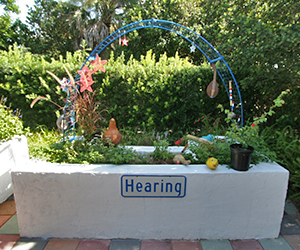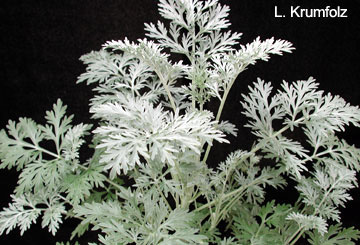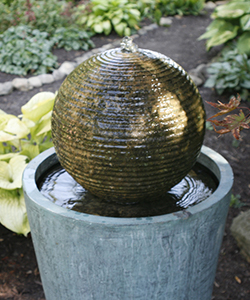Sensory Gardens

While gardeners often choose plants for their visual beauty, you may also want to think about plants that stimulate the other senses. In sensory gardens, plants and other design elements provide experiences for seeing, smelling, hearing, touching, and tasting.
Sensory gardens can be created in spaces of any size, including containers. Some are devoted specifically to one sense, while others focus on several senses.
Sensory gardens can serve many functions. They're used for teaching, socializing, and therapy. These gardens can be designed for specific users, such as children or the blind. Raised beds and wide pathways can make sensory gardens accessible to all.
Sensory gardens encourage interaction with plants, so interpretive signs and access to the plants are important. Choose plants that are people-friendly and use as few pesticides as possible.
Touch
Many gardens rely on our sense of sight to create enjoyment, but touch gardens allow visitors to explore the garden in a more tactile way.
Touch gardens include plants with contrasting textures, including soft and fuzzy or rough and spiky. Think about the velvety feel of a rose petal, or the smooth bark of a crapemyrtle. Some plants, like the Southern magnolia, offer different textures within one plant. Its leaves are slick and leathery on top, but fuzzy and soft underneath. Most artemisia varieties have foliage with a fuzzy texture, and succulent leaves come in range of tactile delights.

Artemisia 'Powis Castle' by L. Krumfolz, UF/IFAS
Touch gardens are especially enjoyable for kids and visually impaired people. Just be sure to place any spiny plants so that no one will accidentally bump into them.
For touch gardens that will receive lots of visitors, choose sturdy plants that can stand up to frequent handling.
Sound
Opening the ears in a garden expands the senses and broadens the garden encounter. Provide seating areas in your sensory garden to pause and hear the sound of wind rushing through the leaves, bamboo stems knock together, grasses rustle, palm fronds sway. Leaves can be left on the ground to crunch underfoot.
Sounds of animals enliven the senses. Squirrels chatter and scramble, while birdsong can fill the garden, especially those with fruiting plants and birdbaths. Accessories for bringing sounds to the garden include waterfalls, fountains, wind chimes, and even music piped in through outdoor speakers.
Fragrance
Scent is one of the strongest human senses, and fragrance gardens can add a new dimension to your landscape. With a little planning, you can create a pleasant fragrance garden using the tangy scent of tea olive blooms, the heady perfume of gardenia flowers, or the resinous smell of pine needles. There are even edible plants such as herbs and citrus that have strong scents.
Some plants release their fragrance with the heat of the sun, while others emit a scent only when crushed. Some plants, like night-blooming jasmine, moon vine, and angel's trumpet, have a scent only at night.
Also on Gardening Solutions


